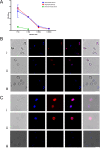A conserved protein of Babesia microti elicits partial protection against Babesia and Plasmodium infection
- PMID: 37649042
- PMCID: PMC10469411
- DOI: 10.1186/s13071-023-05825-x
A conserved protein of Babesia microti elicits partial protection against Babesia and Plasmodium infection
Abstract
Background: The protozoan parasite Babesia microti that causes the zoonotic disease babesiosis resides in the erythrocytes of its mammalian host during its life-cycle. No effective vaccines are currently available to prevent Babesia microti infections.
Methods: We previously identified a highly seroactive antigen, named Bm8, as a B. microti conserved erythrocyte membrane-associated antigen, by high-throughput protein chip screening. Bioinformatic and phylogenetic analysis showed that this membrane-associated protein is conserved among apicomplexan hemoprotozoa, such as members of genera Babesia, Plasmodium and Theileria. We obtained the recombinant protein Bm8 (rBm8) by prokaryotic expression and purification.
Results: Immunofluorescence assays confirmed that Bm8 and its Plasmodium homolog were principally localized in the cytoplasm of the parasite. rBm8 protein was specifically recognized by the sera of mice infected with B. microti or P. berghei. Also, mice immunized with Bm8 polypeptide had a decreased parasite burden after B. microti or P. berghei infection.
Conclusions: Passive immunization with Bm8 antisera could protect mice against B. microti or P. berghei infection to a certain extent. These results lead us to hypothesize that the B. microti conserved erythrocyte membrane-associated protein Bm8 could serve as a novel broad-spectrum parasite vaccine candidate since it elicits a protective immune response against Babesiosis and Plasmodium infection.
Keywords: Antigens; Babesia microti; Bioinformatic analysis; Conserved protein; Vaccine.
© 2023. BioMed Central Ltd., part of Springer Nature.
Conflict of interest statement
The authors declare no competing interests.
Figures






Similar articles
-
Molecular Characterization and Immunological Evaluation of Truncated Babesia microti Rhoptry Neck Protein 2 as a Vaccine Candidate.Front Immunol. 2021 Feb 24;12:616343. doi: 10.3389/fimmu.2021.616343. eCollection 2021. Front Immunol. 2021. PMID: 33717108 Free PMC article.
-
Babesia microti Protein BmSP44 Is a Novel Protective Antigen in a Mouse Model of Babesiosis.Front Immunol. 2020 Jul 7;11:1437. doi: 10.3389/fimmu.2020.01437. eCollection 2020. Front Immunol. 2020. PMID: 32733477 Free PMC article.
-
Babesia microti alleviates disease manifestations caused by Plasmodium berghei ANKA in murine co-infection model of complicated malaria.Front Cell Infect Microbiol. 2023 Jul 10;13:1226088. doi: 10.3389/fcimb.2023.1226088. eCollection 2023. Front Cell Infect Microbiol. 2023. PMID: 37492527 Free PMC article.
-
Comparative Bioinformatics Analysis of Transcription Factor Genes Indicates Conservation of Key Regulatory Domains among Babesia bovis, Babesia microti, and Theileria equi.PLoS Negl Trop Dis. 2016 Nov 10;10(11):e0004983. doi: 10.1371/journal.pntd.0004983. eCollection 2016 Nov. PLoS Negl Trop Dis. 2016. PMID: 27832060 Free PMC article. Review.
-
Vaccination against babesiosis using recombinant GPI-anchored proteins.Int J Parasitol. 2019 Feb;49(2):175-181. doi: 10.1016/j.ijpara.2018.12.002. Epub 2019 Jan 24. Int J Parasitol. 2019. PMID: 30684517 Review.
References
MeSH terms
Substances
Grants and funding
LinkOut - more resources
Full Text Sources
Medical

